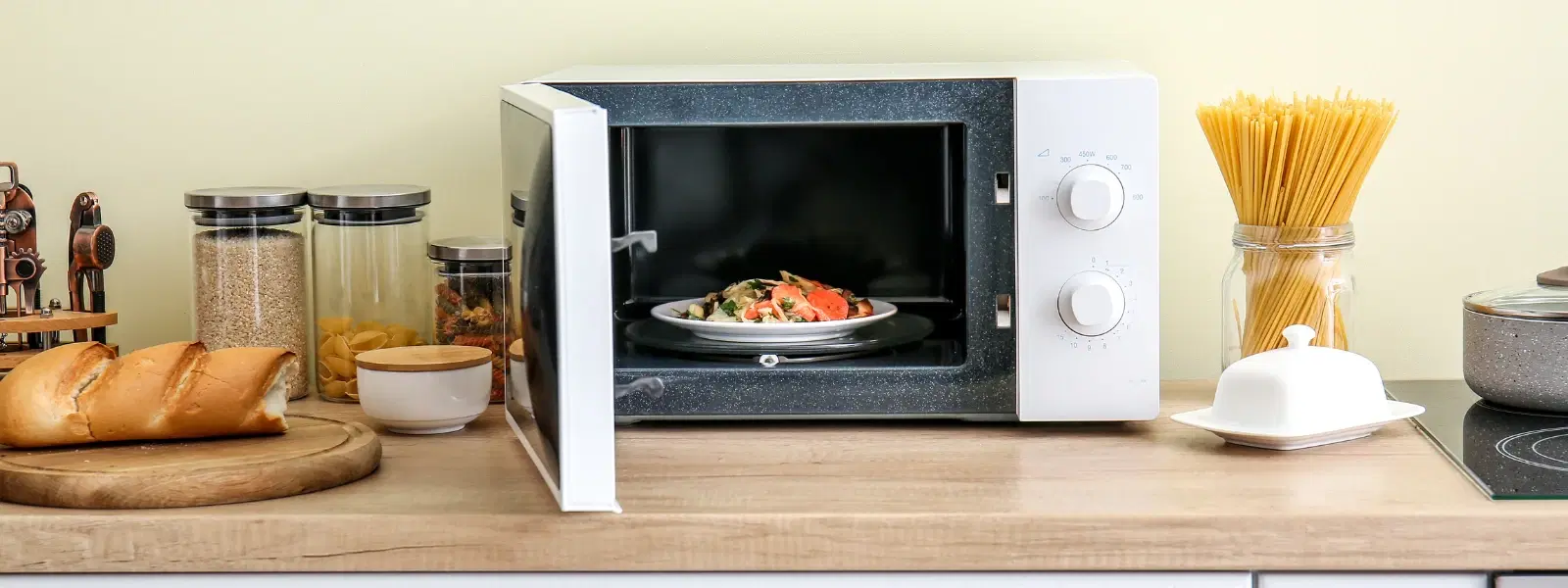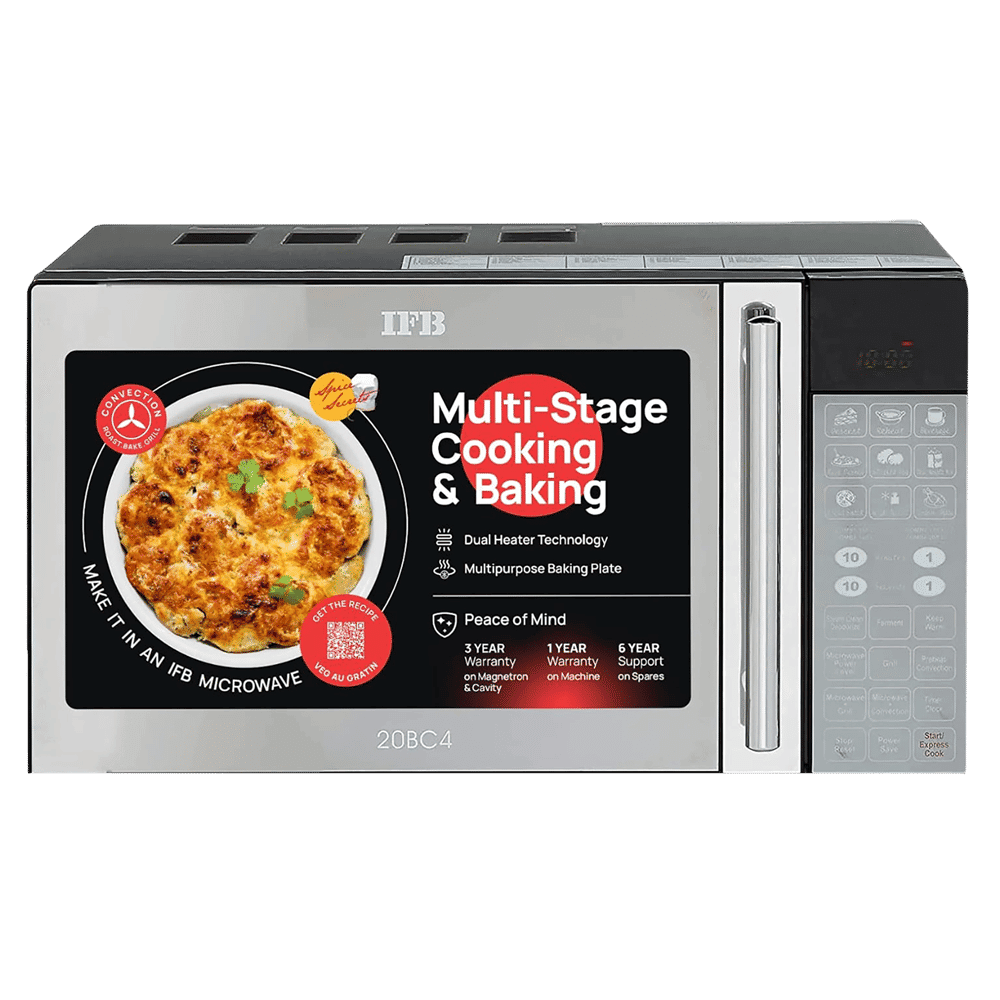
Home Appliances
•04 min read

Buy IFB 30FRC2 30L Convection Microwave Oven with 101 Autocook Menus (Black Floral) online at best prices from Croma. Check product details, reviews & more. Shop now!
Microwaves have revolutionised the way we reheat and cook food, offering convenience at the press of a button. Yet, many still struggle with challenges such as uneven heating, food splatter, or even safety concerns when heating leftovers in microwave. This blog provides clear answers to your frequently asked questions about how to heat food in microwave, along with practical tips and detailed microwave cooking instructions, ensuring you get perfect and safe results every time.
Microwaves use electromagnetic waves to excite water molecules in food. As these water molecules vibrate, they generate heat, which in turn warms up your meal. However, due to variations in food density and shape, this process can sometimes lead to uneven heating. To learn how to warm up food evenly, it helps to understand these basic principles.
Yes, microwave heating is entirely safe when used properly. The appliance does not emit harmful radiation when in operation. Ensuring the use of microwave-safe containers is crucial. Materials such as glass, ceramic, or BPA-free plastic should be used. This not only protects your health but also provides safe microwave reheating by preventing issues like chemical leaching.
For safe microwave reheating, always select containers labelled as microwave-safe. Typically, these include glass, ceramic, or BPA-free plastic items. Avoid using metal or non-microwave-safe plastics, as these can cause hazards or affect the quality of your food.
Food splatter is a common problem during microwave reheating. To prevent food splatter in microwave, cover your dish with a microwave-safe lid or a damp paper towel. Using a splatter guard is another effective method. These simple steps help keep your appliance clean and guarantee safe microwave reheating.
Pro Tip: Preventing Mess in the Microwave
Did You Know? Covering your food with a microwave-safe lid or damp paper towel not only prevents splatter but also helps retain moisture, ensuring your food heats evenly and remains delicious.

Buy IFB 20L Convection Microwave Oven with 71 Autocook Menus (20BC4, Black) online at best prices from Croma. Check product details, reviews & more. Shop now!
Lowering the microwave power settings is an excellent strategy for heating delicate foods or dense meals. When you adjust microwave power settings, reducing the power helps in warming food evenly without overcooking the edges or leaving chilly spots. This technique is particularly beneficial for reheating sauces or defrosting meat.
Another key microwave food heating tip is to reheat food in intervals. By stopping the microwave intermittently to stir or rearrange food, you can prevent overheating and ensure a consistent temperature throughout your dish. This method is one of the best ways to reheat food while preserving its taste and texture.
Achieve uniform heating by following these simple steps: begin by setting your microwave to an appropriate power level. Heat food in short bursts, stirring or rotating your dish after each interval. For items like soups, casseroles, and pizza slices, this method ensures that no section is overdone while another remains cold.
Different leftovers require different approaches. For example, rice and pasta benefit from a splash of water or broth added prior to reheating, which helps retain moisture. For meats, ensure even reheating through stirring or turning. This careful attention to detail is an integral part of safe microwave reheating.
A general microwave reheating guide can be followed for various food items. Begin by choosing the appropriate power level, reheating in short intervals, and using a thermometer to check that the internal temperature reaches 74°C for safe consumption. These instructions help establish a reliable process for heating leftovers in microwave.

Buy IFB 20L Solo Microwave Oven with Timer Option (20PM-MEC2, White) online at best prices from Croma. Check product details, reviews & more. Shop now!
Uneven heating can be caused by several factors including food density, the shape of the container, or the wattage of the microwave. To overcome this, consider rearranging the food midway through heating or using round containers which allow for better distribution of the electromagnetic waves.
Preventing food from drying out during microwave cooking instructions is possible by covering your dish and using lower power settings. Another useful trick is to place a microwave-safe bowl of water inside the microwave, which adds a bit of humidity and can help in keeping your food moist.
Yes, you can heat food directly in a microwave, but it is essential to use microwave-safe containers and avoid materials like metal or non-microwave safe plastics.
Microwaves work by using electromagnetic waves to excite water molecules in the food, which generates heat necessary for cooking or reheating.
Yes, employing proper guidelines such as using microwave-safe containers and avoiding overheating ensures safe microwave reheating.
The reheating time varies according to the type and quantity of food. It's advisable to start with short intervals (for example, 1–2 minutes) and check the temperature frequently.
Microwave-safe containers typically include glass, ceramic, and BPA-free plastics. It is important to avoid using metal or containers that are not labelled as microwave-safe.
Microwaves are a versatile and efficient tool for heating food. By understanding the way they work and following simple tips like selecting the correct containers, adjusting power levels, and reheating in intervals, you can achieve evenly heated and delicious meals every time. The ease and convenience of instruments like these are mirrored by platforms like Tata Neu, which reward you with NeuCoins on smart shopping and offer a range of products, including essential home appliances. For modern tech enthusiasts, families, young professionals, and students alike, mastering the best way to reheat food in your microwave not only saves time but also ensures premium safe microwave reheating as part of a smarter lifestyle.